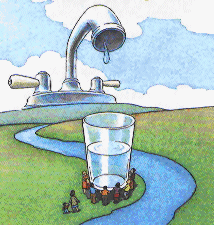
Why would we choose to be writing about water conservation at a time when large areas of Northern California are experiencing flooding? Our area of Northern Nevada narrowly dodged the bullet. If temperatures hadn’t dropped just in the nick of time, our Truckee River would have over flown it’s banks in many places this weekend. We’ve been experiencing a drought here in our area, as do many areas of the world. The rain would have been more welcome if it hadn’t come all at once!
So drought over, right?! We can all go back to letting our water run while we wash dishes and brush our teeth? No. The reason is that with the rise of the earth’s temperatures, we will be seeing more and more extreme weather conditions. For that reason, an integral part of a sustainable home must be water conservation. We will certainly experience weather events that will cause flooding and massive show fall, but we can also expect summers and winters as well to be dryer.
With current local health department ordinances, it can sometimes be difficult to install grey water and rain water catchment systems if you live in a suburban setting. But there is still a lot you can do to live more sustainably and at the same time, be a good citizen of the planet.
The USGS estimates that the average American uses 80-100 gallons of water per day. This is a conservative number. The 2006 United Nations Human Development Report put us at 152 gallons per day. That’s over twice the average annual per capita water consumption rate for the rest of the world.
If you live in California, Nevada, or many other progressive states, you’ll have a toilet that uses 1.6 gallons of water for every flush. Unless you’re now in grade school, you’ll still remember being forced, or paid, to make the change from the old fashioned 4 gallon/ flush toilets. According to the American Water Works Association, here’s how it breaks down:
| Use | Gallons per Capita | Percentage of Total Daily Use |
| Showers | 11.6 | 16.8% |
| Clothes Washers | 15.0 | 21.7% |
| Dishwashers | 1.0 | 1.4% |
| Toilets | 18.5 | 26.7% |
| Baths | 1.2 | 1.7% |
| Leaks | 9.5 | 13.7% |
| Faucets | 10.9 | 15.7% |
| Other Domestic Uses | 1.6 | 2.2% |
If we could convert all households in the US to those 1.6 gallon flushers and other standard water saving plumbing shower heads and faucets, the United States can cut that number down by a substantial 35%.
You might be interested to know that the green building industry is seeking to cut your water usage down even further. In the current issue of Eco Home, you’ll find several articles about what our homes will look like in 2020. Mary Ann Dickinson and Carole Baker discuss a hyper-water-efficient home where a family of four will use about 2,500 gallons per month for inside and outside use! This isn’t some futuristic dream, this is a looming reality. Right now, manufacturers are developing toilets that will use only .5 gpf and even that, will come from filtered “grey water”. That’s water that was used in your shower, washing machine, sink drains and dishwashers. Companies are developing more water efficient products because they know that there is going to be a market for them in the future.
Other products on the horizon? There will soon be clothes washers that use 10 gallons per load and dishwashers that use 4 gallons per load. When homes are designed to be sustainable, these appliances as well will use recycled grey water. Water use data will be available on your iPad along with energy use data.
What does this mean for those seeking to live sustainably, and especially self-sustainably? The costs for sustainable water practices are going to come down, while the choice of products is going to go up. If you choose to live with a water catchment system, it will be easier to do in dryer climates.
If you have any experience with water catchment or grey water systems, we would love for you to share your knowledge and expertise with us.





You must be logged in to post a comment.